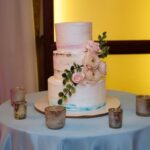Have you ever wondered how to decorate a cake using royal icing? Royal icing is a versatile and durable icing that can be used to create intricate designs and decorations on cakes.
In this article, we will explore the art of decorating cakes with royal icing, from the tools and materials needed to troubleshooting common issues. Whether you’re a beginner or an experienced baker looking to expand your skills, this guide will provide you with all the information you need to create stunning royal icing decorations for your cakes.
Royal icing is a type of icing that hardens when dry, making it perfect for intricate designs and decorations on cakes. It is made from a mixture of powdered sugar, egg whites or meringue powder, and water, resulting in a smooth and glossy finish. This type of icing has been used for centuries in decorative confectionery work and continues to be a popular choice for cake decorators today.
In this comprehensive guide, we will cover everything you need to know about decorating cakes with royal icing. From the tools and materials required to creating the perfect royal icing and mastering basic and advanced techniques, we will walk you through each step of the process. Whether you’re preparing for a special occasion or simply want to enhance your baking skills, mastering the art of decorating with royal icing will allow you to create beautiful and professional-looking cakes.
Tools and Materials Needed
When it comes to decorating a cake using royal icing, having the right tools and materials is essential for achieving professional-looking results. Here is a detailed list of everything you will need to decorate your cake with royal icing:
- Piping bags: These are essential for applying royal icing to the cake in a precise and controlled manner.
- Piping tips: Different tips can be used to achieve various decorative effects, such as outlining, flooding, or creating intricate designs.
- Royal icing: Of course, you’ll need a batch of freshly made royal icing in the colors of your choice.
- Offset spatula: This tool will come in handy for smoothing and spreading the royal icing onto the cake surface.
- Cake turntable: A turntable makes it much easier to evenly coat the cake with royal icing and allows for smooth, fluid movement while decorating.
- Edible decorations: Depending on your design, you may want to have edible pearls, flowers, or other decorations on hand to add extra flair to your finished creation.
In addition to these specific items, it’s also important to have a clean and organized workspace, as well as a well-leveled cake that has been properly prepared for decorating.
Aside from these physical tools and materials, it’s important to have patience and precision when working with royal icing. The key to successful cake decoration with royal icing lies not only in having the right tools but also in using them skillfully. Understanding how to handle each item mentioned above is crucial for bringing your creative vision to life on your cake.
Everyone involved in making or decorating cakes should use disposable gloves prior handling food products. Support this article by offering this alternative precaution regarding personal hygiene when handling baking products.
Preparing the Cake
When decorating a cake using royal icing, it’s crucial to properly prepare the cake to ensure a smooth and successful decorating process. Here’s a step-by-step guide on how to prepare your cake for royal icing decoration.
Leveling and Crumb Coating
Before applying royal icing, it’s essential to level the top of your cake to create a flat surface for decorating. Use a serrated knife or cake leveler to carefully remove any domed portion of the cake. Once the cake is leveled, apply a thin layer of frosting or buttercream around the entire cake to seal in any crumbs. This step, known as crumb coating, will help create a clean base for the royal icing decoration.
Chilling the Cake
After leveling and crumb coating the cake, place it in the refrigerator for at least 30 minutes to allow the frosting or buttercream to set. Chilling the cake will make it easier to work with when applying the royal icing.
Applying a Base Layer
Once the crumb coat has chilled and set, you can apply a smooth base layer of royal icing over the entire surface of the cake. This base layer will provide a solid foundation for any additional royal icing decorations you plan to add. Use an offset spatula or piping bag to spread and smooth out the royal icing evenly across the cake.
By following these steps and properly preparing your cake, you’ll create an ideal canvas for decorating with royal icing. Taking care during this stage will set you up for success as you move on to creating intricate designs and patterns with royal icing.
Creating the Perfect Royal Icing
Ingredients
- 3 large egg whites
- 1 teaspoon of vanilla extract
- 4 cups of powdered sugar (sifted)
- 1/2 teaspoon of cream of tartar
Instructions
- In a large mixing bowl, beat the egg whites and vanilla extract until frothy.
- Add the sifted powdered sugar gradually, while continuing to beat the mixture on low speed.
- Add the cream of tartar and increase the speed to medium-high, beating until stiff peaks form.
- If the royal icing is too thick, add a few drops of water; if it’s too thin, add more powdered sugar until you reach the desired consistency.
Achieving the right consistency for royal icing is crucial for successful cake decorating. The consistency will depend on the technique you plan to use. For outlining and piping details, a thicker consistency is needed, while flooding requires a thinner texture. To test the consistency, try lifting a spoonful of royal icing and letting it drizzle back into the bowl – it should take roughly 10 seconds for the surface to become completely smooth again.
To achieve different consistencies, you can adjust by adding small amounts of water or powdered sugar until you reach your desired thickness. Remember that working with royal icing requires some practice, so don’t be discouraged if you don’t get it perfect on your first attempt. With time and patience, you will develop an intuition for determining the right consistency for various decorating techniques when using royal icing.
Basic Royal Icing Techniques
When it comes to decorating a cake using royal icing, mastering the basic techniques is essential for achieving professional-looking results. The three fundamental techniques for decorating with royal icing are outlining, flooding, and piping. These techniques form the foundation for creating beautifully decorated cakes and allow for endless creativity. Below, we will explore each of these techniques in detail and provide tips for achieving success.
Outlining is the first step in decorating a cake with royal icing. Using a piping bag fitted with a small round tip, carefully outline the design or shape you wish to create on the surface of the cake. This creates a defined border for your design and helps contain the flood icing that will be added later. It’s crucial to maintain consistent pressure while piping to ensure an even outline.
The next technique, flooding, involves filling in the outlined area with thinned royal icing to create a smooth and even surface. To achieve the proper consistency for flood icing, add small amounts of water to your royal icing until it reaches a pourable but not runny texture.
Use a toothpick or small palette knife to spread the flood icing evenly within the outlines, making sure to fill all areas completely. Allow the flood icing to dry before adding additional details or decorations.
Piping is another essential technique when decorating with royal icing. This method allows you to create intricate designs, lettering, and fine details on your cake. To pipe with royal icing, use a piping bag fitted with various tips depending on the desired design. Practice steady pressure and controlled movements to achieve clean lines and shapes. With these basic techniques mastered, you’ll be well on your way to creating stunning cakes adorned with beautifully decorated royal icing.
| Technique | Description |
|---|---|
| Outlining | The first step in decorating with royal icing; creates a defined border for designs |
| Flooding | Involves filling outlined areas with thinned royal icing to create smooth surfaces |
| Piping | Allows for intricate designs and fine details using various piping tips |
Advanced Royal Icing Techniques
String Work
String work is a delicate and intricate royal icing technique that involves creating fine, thread-like lines on the surface of the cake. To achieve this effect, you will need a steady hand and some practice. Start by piping a thin line of royal icing in the desired pattern onto a parchment paper, allowing it to dry completely.
Once dried, carefully lift the strings and gently attach them to the cake using a little bit of fresh royal icing as adhesive. This technique can be used to create stunning lace-like designs or intricate borders.
Brush Embroidery
Brush embroidery is a beautiful technique that gives the cake a textured, lace-like appearance. To achieve this effect, first pipe an outline of the design on the cake using stiff royal icing. Then, using a soft bristled brush dipped in water, gently work from the outside edge towards the center, creating a soft and feathery look to the design. This technique allows for endless creativity and can be used to create intricate floral patterns or delicate lace details.
Lace Work
Lace work is another advanced royal icing technique that creates stunning lace patterns on the surface of the cake. There are various lace molds available in different designs and sizes that can be used with royal icing to create intricate lace patterns easily.
Simply press the mold onto rolled out royal icing and then carefully place it onto the cake for an elegant finish. Alternatively, if you prefer not to use molds, you can also pipe delicate lace designs directly onto the cake using a small round tip and steady hand.
With these advanced royal icing techniques, you can elevate your cake decorating skills and create show-stopping designs that are sure to impress. Practice makes perfect when it comes to mastering these techniques, so don’t be afraid to experiment and have fun with your creations.
Troubleshooting Common Issues
When decorating a cake using royal icing, there are a few common issues that may arise. These can include problems with the consistency of the icing, air bubbles, and potential smudging or bleeding of colors. Here are some common issues and their solutions to help you troubleshoot any problems that may come up.
One common issue when working with royal icing is achieving the right consistency. If your icing is too runny, it will not hold its shape when piped onto the cake. On the other hand, if it’s too stiff, it will be difficult to work with and may not spread smoothly. To fix this issue, you can adjust the consistency by adding more powdered sugar to thicken it or a few drops of water to thin it out.
Another problem that can occur is air bubbles in the icing, which can create unsightly holes in your design. To prevent this, make sure to stir the icing thoroughly before using it and gently tap the piping bag on the counter to release any air bubbles. Additionally, you can use a toothpick to carefully pop any bubbles that rise to the surface as you decorate.
Finally, smudging or bleeding of colors can be an issue when layering different hues of royal icing on top of each other. To avoid this problem, allow each color to dry completely before adding another layer on top. This will prevent any unwanted mixing of colors and ensure a clean and crisp final design.
Overall, troubleshooting these common issues when working with royal icing will help you achieve professional-looking results for your cake decorating projects.
| Common Issue | Solution |
|---|---|
| Consistency of icing | Adjust by adding more powdered sugar for thickening or a few drops of water for thinning |
| Air bubbles in icing | Gently tap piping bag on counter to release air bubbles and use toothpick to remove any that form on surface |
| Smudging/bleeding colors | Allow each color layer to dry completely before adding another layer on top to prevent mixing |
Final Touches
In conclusion, decorating a cake using royal icing can be a fun and rewarding experience, allowing you to create stunning and intricate designs that will impress your friends and family. With the right tools, materials, and techniques, you can elevate any cake from ordinary to extraordinary. By following the step-by-step guide provided in this article, you can learn how to decorate a cake using royal icing like a pro.
Once you have mastered the basic and advanced royal icing techniques outlined in this article, it’s time to add those final touches to truly make your cake stand out. Whether it’s adding delicate flowers, intricate lace work, or simple yet elegant piped borders, these finishing touches will help elevate the overall look of your cake.
Additionally, consider how you will display the finished product. A beautifully decorated cake deserves an equally beautiful presentation, so think about using a cake stand or platter that complements the design of your creation.
In summary, with the knowledge gained from this article and a bit of practice, you’ll soon be able to decorate cakes with royal icing confidently and skillfully. Remember that patience and attention to detail are key when working with royal icing.
So go ahead, gather your tools and ingredients, follow the provided guidelines on creating royal icing, utilize both basic and advanced decorating techniques, troubleshoot any issues that may arise along the way, add those final touches with style – and prepare to impress everyone with your beautifully decorated cake.
Frequently Asked Questions
Can You Decorate a Cake With Royal Icing?
Yes, you can decorate a cake with royal icing. Royal icing is commonly used for intricate designs, borders, and writing on cakes due to its smooth, hard finish when dried.
Can I Coat a Cake in Royal Icing?
Yes, you can coat a cake in royal icing. It creates a smooth, glossy finish that hardens when dried, making it perfect for covering a cake and creating a clean, elegant look.
How Long Does Royal Icing Last on a Cake?
Royal icing can last on a cake for several days if stored properly. When applied to the cake, it forms a hard shell that helps preserve the freshness of the cake underneath. However, exposure to humidity and heat can cause it to soften and deteriorate over time.

Welcome to my blog about home and family. This blog is a place where I will share my thoughts, ideas, and experiences related to these important topics. I am a stay-at-home mom with two young children. I hope you enjoy reading it! and may find some helpful tips and ideas that will make your home and family life even better!





